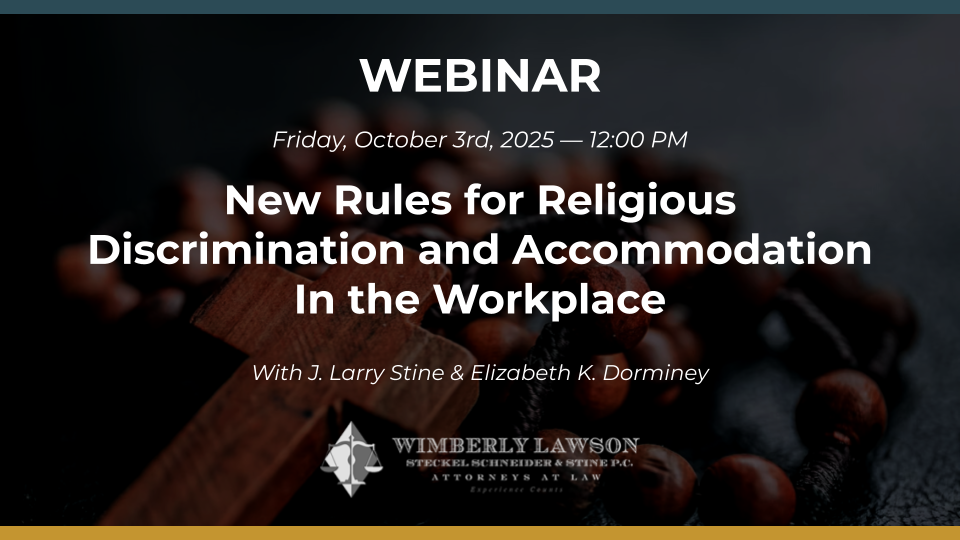HOW TO MANAGE THE RETURN OF SOCIAL SECURITY NO-MATCH LETTERS
Social Security "no-match" letters generate a great deal of concern in the employer community as to how to handle such issues. Immigration and Customs Enforcement (ICE) has in the past taken the position that receipt of one of these notifications creates an affirmative duty to investigate and potentially take action, at least to avoid a potential finding of constructive knowledge of illegal employment. On the other hand, the Immigration and Employee Rights Section (IER) of the Department of Justice has strict rules as to whether employers are going too far in their employment verification duties. At one time, federal regulations provided a safe harbor procedure for handling these issues, but the Obama Administration rescinded the regulation and suspended the issuance of Social Security mis-match letters in 2012. Thus, this year will be the first time in seven years that employers will receive Social Security no-match letters when the government has discovered that the W-2 records submitted by the employer do not match the government's records on employee names and Social Security numbers (SSNs).
In the past, ICE has taken the position that an employer must take affirmative action upon discovering a Social Security discrepancy, but the discrepancy is only "evidence" of constructive knowledge of unauthorized employment. In 2011, the predecessor to IER provided specific "dos and don'ts" related to no-match letters. The most important suggestions in the IER guidance are as follows:
|
DO: |
DON'T: |
|
1. Check the reported no-match information against your personnel records. |
1. Use the receipt of a no-match notice alone as a basis to terminate, suspend or take other adverse action against the employee. |
|
2. Inform the employee of the no-match notice and ask the employee to confirm the name/SSN reflected in your personnel records. |
2. Attempt to immediately reverify the employee's employment eligibility by requesting the completion of a new I-9 form based solely on the no-match notice. |
|
3. Advise the employee to contact the SSA to correct and/or update SSA records. |
3. Follow different procedures for different classes of employees based on national origin or citizenship status. |
|
4. Give the employee a reasonable period of time (no specific time period is listed) to address a reported no-match with the local SSA office. |
4. Require the employee to produce specific I-9 documents to address the no-match. |
|
5. Periodically meet with or otherwise contact the employee to learn and document the status of the employee's efforts to address and resolve the no-match. |
5. Require the employee to provide written evidence from SSA that the no-match has been resolved. |
|
6. Submit any employer or employee corrections to the SSA. |
SSA began issuing letters called Employer Correction Requests in March 2019. These letters do not include the names or SSNs of employees. Instead, the letters ask employer to register online with SSA's business services unit to obtain the no-match information.
Editor's Note: The author recently had a review by IER of a client's immigration practices. IER pressed our client to avoid any type of adverse action against their employees solely because of a no-match letter. This position leaves employers in the dark as to what they should do. In general, employers must investigate, at least to show some responsive action. They would not necessarily have to terminate each employee that is the subject of a no-match. Note that ICE audits normally request employer records concerning no-match letters. The big issue is when or if an employer is required to terminate an employee who has failed to show a correction of the mismatch issue by the SSA. There appear to be more Social Security mismatches than there are unauthorized immigrants, and multiple reports of a mismatch often involve the same Social Security number. The mismatch notices themselves have often disclaimed reliance on them as the sole basis to terminate an employee. Further, SSA itself often takes 120 days and sometimes more to correct a mismatch.
In this situation, employers need legal counsel as to what approach to take when no confirmation from SSA of a correction is received. A reasonable option is to give employees plenty of time to confirm the correction, such as 60 to 120 days, and another controversial option is to allow employees to provide other identity and work authorization documents sufficient to complete a new I-9 form in appropriate situations.
Related Content
Get Email Updates
Recent Content

Trump Nominates Appointments to NLRB and EEOC but Policy Changes Likely to Be Delayed

DOL Launches Self-Audit Programs Designed to Help Employers Improve Compliance

DOL Must Release EEO-1 Reports to the Public under Open Records Laws

Current Advice on Active-Shooter Situations

New Policy for Federal Workers and Religious Expressions

